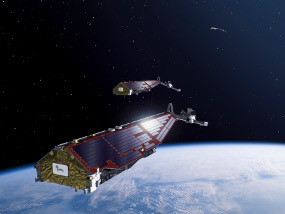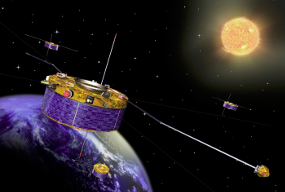Seven ESA satellites team up to explore Earth's magnetic field
1 July 2015
For the first time ever, two of ESA's flagship space missions – Cluster and Swarm – have joined forces to simultaneously measure the properties of Earth's magnetic field at two different altitudes.The satellites found a number of striking similarities in the behaviour and structure of the field-aligned currents detected at each altitude, despite their vastly different locations. Field-aligned currents (FACs) flow along Earth's magnetic field lines, transferring energy from region to region.
 |
| Locations of Cluster and Swarm during the study of April 2014. The study showed that it is highly likely that both missions sampled the same large-scale field-aligned current. Credit: ESA/ATG medialab. (See also the more detailed figure here.) |
This is the first time that multiple spacecraft have simultaneously and directly measured the current density of the magnetic field surrounding our planet at each location. Their results not only explore and characterise the magnetic behaviour in the space around our planet, but also directly show a clear link between field-aligned currents flowing at different altitudes around the Earth.
 |
| Artist's impression of the Swarm spacecraft. Credit: ESA–P. Carril, 2013 |
One of the key aims of ESA's Swarm mission, consisting of three satellites launched in November 2013 into low Earth orbit, is to probe and explore the strength, properties, and dynamics of Earth's internal magnetic field in greater detail than ever before.
However, the satellites' delicate sensors also pick up the natural and powerful electric currents flowing throughout our planet's ionosphere and magnetosphere, driven by the wind of charged particles streaming from the Sun. The ionosphere is an ionised region of Earth's upper atmosphere extending upwards to about 1000 km, with the magnetosphere, the region in which Earth's magnetic field dominates, sitting above it and stretching much further out into space.
Ionospheric currents are thought to be connected to those in the magnetosphere via FACs. Understanding and separating the various magnetic sources and streams is vital so that missions like Swarm can isolate Earth's more subtle interior dynamics – FACs in particular are known to disturb such measurements in the planet's polar regions.
"Swarm and Cluster took readings at altitudes of 500 and 15 000 kilometres respectively," explained Malcolm Dunlop, lead author of the new study. Dunlop is a professor at Beihang University in Beijing, China, a visiting professor at Imperial College London, UK, the PI institute for Cluster's magnetometer, and a space environment scientist at RAL (STFC), UK.
"The Swarm spacecraft are orbiting just within the ionosphere, whereas Cluster is in the magnetosphere, so they're in very different regions of space," he added. "The data sent back by both missions show that large-scale FACs in the measured regions have clearly matching behaviour and structure – the first time this has been seen directly from local magnetic gradients."
 |
| Artist's impression of the Cluster flotilla. Credit: ESA |
Dunlop and colleagues analysed measurements from 22 April 2014, as Cluster and Swarm were magnetically conjugate – while not close in space, they were closely magnetically aligned, as they were located along the same field line. Cluster, in flight since 2000, was the only mission able to measure the magnetosphere's electric currents via four individual satellites, while Swarm is able to measure electric currents via close groupings of two or three spacecraft.
The satellites can measure different aspects of the field's spatial and temporal variation depending on the properties and configuration of their orbits, relative to both one another and the Earth. The team made measurements with the spacecraft in different configurations – or constellations – and produced various multi-point spacecraft estimates, with each spacecraft located at a 'point'.
"The spacecraft constellations also allowed us to explore all the components of the current density," added Dunlop. "We were able to look at both field-aligned and perpendicular signatures."
The team found clear evidence of both small- and large-scale FACs from Swarm. The Cluster data then showed that the large-scale measurements beamed back from an altitude of 500 km were remarkably similar to those gathered at 15 000 km in both form and scaled current strength – in fact, it is highly likely that both missions sampled the same large-scale FAC.
"These results directly demonstrate the FAC linkage between the ionosphere and the magnetosphere," says Dunlop. "This in situ multi-spacecraft constellation analysis was key. Previously, only single spacecraft measurements, which can't unambiguously resolve currents, were available at low Earth orbit."
Understanding more about Earth's magnetic field is important; strong currents in the ionosphere can disrupt the power grid, and other grounded conductors, via induced electrical currents. They can also cause power networks to become unstable, and even trigger component burnout in transformers and other electrical devices.
These findings are relevant to the objectives of both the Cluster and Swarm missions. "The cooperation between both missions has been fantastic," added Philippe Escoubet, ESA Project Scientist for the Cluster mission.
"In the spring of 2014 the two joined up to better understand a lot of the complex magnetic behaviour seen around the Earth – such as FACs and dynamics in the magnetosphere that may impact the Earth's magnetic field. They'll continue to work together in the future, too, with more special joint campaigns planned all the way until 2018."
Background Information
The results described in this article are reported in "Simultaneous field-aligned currents at Swarm and Cluster satellites", by M. W. Dunlop, J.-Y. Yang, Y.-Y. Yang, C. Xiong, H. Lühr, Y. V. Bogdanova, C. Shen, N. Olsen, Q.-H. Zhang, J.-B. Cao, H.-S. Fu, W.-L. Liu, C. M. Carr, P. Ritter, A. Masson, and R. Haagmans, published in Geophysical Research Letters. DOI: 10.1002/2015GL063738.
This paper is one of a series of scientific papers published recently in Geophysical Research Letters and collected in a special issue highlighting results of Swarm one year in orbit.
Cluster is a constellation of four spacecraft flying in formation around Earth. It is the first space mission able to study, in three dimensions, the natural physical processes occurring within and in the near vicinity of the Earth's magnetosphere. Launched in 2000, it is composed of four identical spacecraft orbiting the Earth in a pyramidal configuration, along a nominal polar orbit of 4 × 19.6 Earth radii (1 Earth radius = 6380 km). Cluster's payload consists of state-of-the-art plasma instrumentation to measure electric and magnetic fields over wide frequency ranges, and key physical parameters characterising electrons and ions from energies of near 0 eV to a few MeV. The science operations are coordinated by the Joint Science Operations Centre (JSOC) at the Rutherford Appleton Laboratory, United Kingdom, and implemented by ESA's European Space Operations Centre (ESOC), in Darmstadt, Germany.
Swarm, a constellation of three satellites, studies Earth's magnetic field. Swarm aims to offer a unique view inside Earth: to study core dynamics, geodynamo processes and core–mantle interaction; magnetism of the lithosphere and its geological context; 3D electrical conductivity of the mantle related to composition; and magnetic signature related to ocean circulation. In addition, Swarm data will be used to study the Sun’s influence on the terrestrial system by analysing electric currents in the magnetosphere and ionosphere. It will also play a role in improving our understanding of the impact of the solar wind on the dynamics of the upper atmosphere. Each satellite carries a vector and absolute scalar magnetometer, an electric field instrument, an accelerometer, a GPS receiver, star trackers and laser retroreflectors. The Swarm satellites were launched on 22 November 2013 on a Rockot launcher from Plesetsk, Russia. Mission control is carried out at ESA's European Space Operations Centre (ESOC) in Darmstadt, Germany and science data are distributed through ESA’s centre for Earth observation (ESRIN) in Frascati, Italy.
Contact
Malcolm Dunlop
Space Sciences Division, RAL space, STFC
Rutherford Appleton Laboratory
United Kingdom
Phone: +44 1235 44 5427
Email: malcolm.dunlop![]() stfc.ac.uk, m.w.dunlop@rl.ac.uk
stfc.ac.uk, m.w.dunlop@rl.ac.uk
and
Beihang University, Beijing, China
Philippe Escoubet
Cluster Project Scientist
Scientific Support Office
Directorate of Science & Robotic Exploration
ESA, The Netherlands
Phone: +31 71 565 3454
Email: Philippe.Escoubet![]() esa.int
esa.int
Arnaud Masson
Cluster Deputy Project Scientist
Science Operations Department
European Space Astronomy Centre, ESA, Spain
Email: Arnaud.Masson![]() esa.int
esa.int



